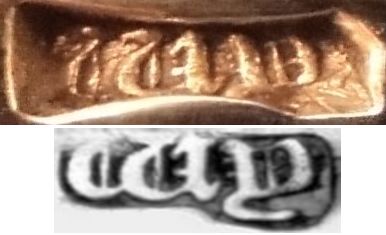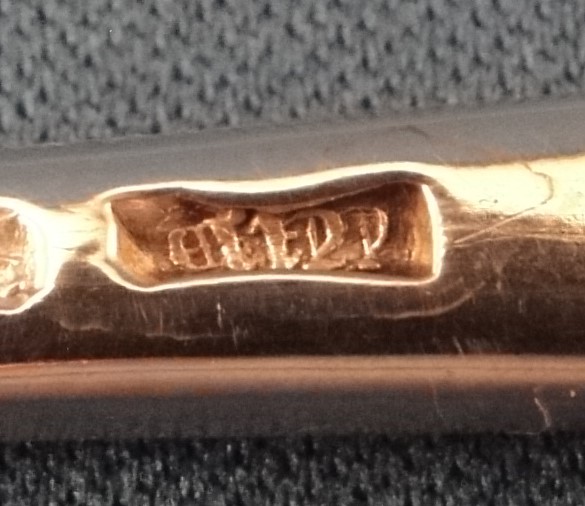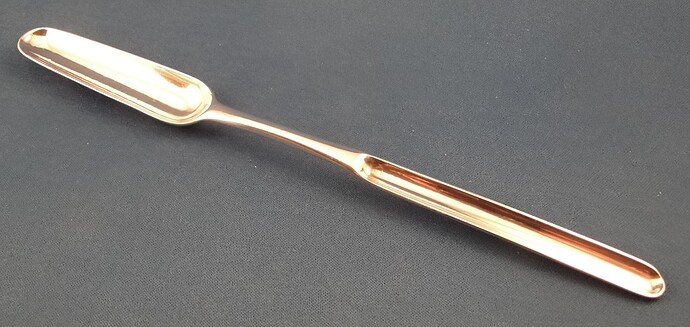The picture is of the makers mark on a marrow scoop. There is a lions head for London. The date mark is h for 1743, but I just can’t make out what this makers mark is.
I can’t work it out either. Unfortunately I am away from home and my references so can’t do any more research at the moment.
Phil
Whole item photo, please.
I admit that deciphering the riddle is neither obvious nor easy. My imagination suggests the letters B, H, E, J, R in various configurations, but these are just free speculations. London and the year are definitely correct. I keep looking, I don’t give up.
I can’t work out the sponsor’s either, but the hour I spent demonstrating that to myself and writing this short polemic may be of some slight interest to blog readers who have more patience, better data access or younger eyes than I or all of the above.
The esteemed Phil Osborn has told us he is on holiday but he has left behind for the rest of us his excellent website: silvermakersmarks.co.uk. which was key in this search which I have outlined for whatever that is worth.
So, starting with the marks for the date and Assay Office, I was able to quickly confirm Mr. Dawson, the poster was right on the button; it is indeed a lower case “h” dating it for 1743 and a crowned leopard’s head for the London Office. This fitted with the look and imagined feel of the item. Turn your computer screen everything which way until you can see an identifiable letter, then look to see if the leopard/lion’s head town mark is crowned as this is. This means the mark is before 1820. You can see the cross on the crown most easily.
The maker’s mark is stamped and illustrated upside down. Turn it around and we may well have a gothic W. This often happens as the mark for maker or sponsor is applied before submission to the assay office which then adds the additional marks for lion passant (standing with one foot raised) for sterling, town, date and, later excise duty sovereign’s head
So now using Phil’s website and Jacksons we are looking for gothic W’s for a first name in a plain rectangle, squashed by the handle production, appearing in a date range which encompasses 1743.
Jacksons shows William Stocking who’s second letter “s” doesn’t appear, even distortedly, in this mark and isn’t reproduced by Phil in his website.
So that leaves two possibilities: William Justis whose mark is a rectangle with a bit extra on the end in Phil’s web site and without in Jacksons at p. 192. One more: William Coles, but try as I might, squint as I can, that straight line of this mark following the W doesn’t to me assist in creating in mind’s eye a Gothic “C”.
So if this a Justis mark, as depicted by Jacksons in a plain rectangle with the J rendered by wear as a straight line, which is there following by another smaller letter? Can’t be as with all marks back then there were only two letters. Was this not the case the first letter might be a U. Which it isn’t. So this is either a distorted J or not his mark at all.
Justis was apprenticed to John Fawdery in 1712, turned over to Richard Bayley in 1718, free 1721. His first mark was entered as large worker between April 1731 and January 1733, his second mark, perhaps this one, was entered in 1739. His son, also William, was apprenticed to him in 1747, turned over to David Field.His mark is often found on salvers. I have a pepper pot and have seen a pap boat and mugs with his mark. I cannot find a marrow scoop by him.
And this is the problem with marks on marrow scoops. Scoops are too easy to make and too basic a table top tool back then and silversmiths of the period, George I, II and III, made them by the hundreds.
Most have been recycled because, unless you wander into very smart eateries, scooping marrow out of cow bones has lapsed as a table delicacy
There are other gothic letter sponsor mark configs of the time, William Gould for instance but his mark had a wheatsheaf above it and that does not appear even in a squeezed and contorted fashion.
I have not looked at Arthur Grimwade’s still definitive book on London Goldsmiths mostly because the silver makers marks website scour and mines it so efficiently and regularly there is hardly need.
If Grimwade doesn’t help and the modern online indexes don’t have the makers mark in question there could be another rather darker explanation, either it is a US faux UK mark which after the Revolution (War of Independence this side of the pond) happened especially in New York where the often Dutch smiths had little regard to the British marking system, or it is just a fake.
I don’t think it is either American or a fake, the marks which do appear are too good, too correctly worn and it’s not worth faking items which sell for little more than the melt value of the silver the implement in the first place.
I have seen other Justis marks badly distorted, so deductively, since I have no viable alternative that is what I have left. But I don’t have that “done and dusted” feeling I should.
Christopher
Guildhall Antiques
Toronto
Thank you, Christopher, for setting the historical background information in your inimitable and entertaining fashion. However I think that I have found a very plausible alternative to either of your two suggestions. The mark is certainly upside down in the image and definitely starts with a W. So I am pretty confident that it is the mark of William Young. The mark of his which I show below was registered in 1739 and he is not recorded as registering any further marks before his death in 1755. I have seen his mark on marrow scoops and other flatware.
I have adjusted the size of my image of his mark so that it can be directly compared with the original image:

Phil
London Makers Marks - WT-WZ
William Young 1739…1743 (registered Jun 1739).
Phil, I didn’t notice you already solved the puzzle. ![]()
Brilliant. I ran out of steam at WT on your website! All of which is determining two things for me; first that I probably need to wander down to my optician and get a new pair of spectacles and secondly that you, or for that matter anyone, can now build a AI agent to create a model to do the W A through WZ search I failed to complete on the web for maker’s marks where only one letter is distinguishable.
This in turn raises another problem: you have worked extremely hard and for the general public good to create a website which is sort of Jackson’s on steroids --in so far as you can update it 24/7 and poor old Jackson,or Grimwade, has to seduce a publisher each time to get an update.
But how do you protect its content from third party AI exploitation? Copyright of the content you might have but not of the marks which if they have any protection at all would have to be under Trade Mark legislation and that, if I recall, is only 50 years.
May I explain? I wrote my little story about failing to find the mark you so efficiently and quickly retrieved, once you were reunited with your books, not to answer questions about who, although that would have been a bonus, but to demonstrate modus operandi to anyone curious about methodology.
For this website I did it as a script for another nascent product I am doing it as a live-stream on Only Fans — yes the site where remarkably talented, or at least nubile young women manage to take off their clothes and put noughts on their bank accounts all in one fell swoop.
So far that product which is long term agrarian out of central America effort has produced nothing and the Only Fans stream produced about that postponed success about $15,000 in the first month and can continue to do that for so long as I can be bothered to write it and illustrate the treatment.
So what does all this have to do with Silver Makers Marks? Well, as me old dad said as he labored away producing beer for the inter-war thirsty in your Black Country “The only way to get ahead is to stay ahead.”
And you thought retirement was going to mean relaxing!
CRWW
Christopher, I bow to your knowledge, education and sense of humor. It was your post that led me to the right solution. Thank you!
That, I think is how this platform is supposed to work. Kind of you to say so and a nod to the web forum’s creators for maintaining a place where mutual respect seems to allow us all to thrive despite our idiosyncratic preoccupation with the marks of long dead metal bashers.
So what do we know about Young? Flatware, dead in 1855 and mark registered in 1739. Live Auctioneers throws up an American coin silver footed card tray, attributed to. southern US silversmith William Young of Hagerstown, MD, 1795-1804 and later Staunton, VA, 1806-1839. and there was another William Young in Dundee. But neither is our guy.
His paucity of marked attribution may have something to do with how gingerly he stamped his gear. Because, given he served the usual seven-year apprenticeship ending in 1739 he was born right at the beginning of the18th century and hung on for 55 years or so.
Mind you, staying out of silversmith workshops with their off gassing mercury vapor and sledge-hammer banging might have been an excellent way to prolong 18th century life without any other effort,
Do you notice how quickly they turned over before about 1840? And the one’s that did survive, like my lot, who went nimbly from silver to religion thence to gin and beer, only did so by focusing on metal banking rather than metal banging.
CRWW
That is such impressive knowledge and problem-solving! Isn’t it strange how it’s so hard to see, but then so obvious when it’s pointed out. Thank you everyone.
Mark.
What a forum! What a lot of inspiring contributors! I bow to thee also. Makes me so glad to have become a (albeit small-time) silver flatware collector with an inborn sense of curiosity.
Gratefully
Jan


